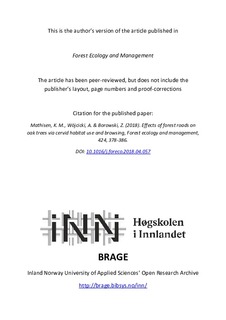Effects of forest roads on oak trees via cervid habitat use and browsing
Journal article, Peer reviewed
Accepted version
Permanent lenke
http://hdl.handle.net/11250/2576594Utgivelsesdato
2018Metadata
Vis full innførselSamlinger
Originalversjon
Forest Ecology and Management. 2018, 424 378-386.Sammendrag
Roads can affect animals in several ways, by affecting movement, space use, foraging behavior and mortality. As roads often have a negative effect on populations of birds and mammals, their effects are important for wildlife management. However, the effect of roads differ between different types of roads, and most studies of road ecology have focused on major roads with high traffic intensity, whilst effects of smaller unpaved forest roads in northern ecosystems are less known. We investigated the effects of forest roads in a mixed conifer forest in central Europe on cervid habitat use and browsing impact on forest regeneration during the winter season. We found that hunted cervid species avoided forest roads, and that browsing pressure was higher within the core of forest areas rather than close to roads. This led to an increased density of undamaged trees (by browsing) close to forest roads, whilst browsing damages were relatively high in the interior. Hunters often use these forest roads in the hunting season. We suggest that human disturbance creates corridors of fear along forest roads, and that cervids alter their habitat and browse use to avoid humans. This in turn has implications for forest and cervid management. This is the first study to document that gravel roads can affect oak trees through modifying cervid behavior. Future studies should use experiments to explore this question further and separate different effects of forest roads to understand the mechanisms; edge effects on vegetation, traffic, effects on natural predators and human disturbance. Effects of forest roads on oak trees via cervid habitat use and browsing
